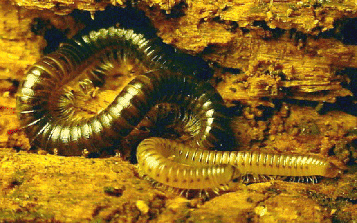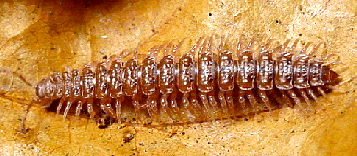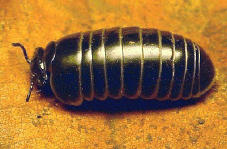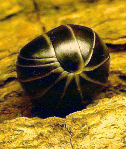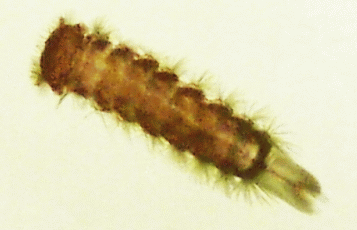
Consulting Entomologist

Tel/Fax: 01275 854224
E-Mail: [email protected]
Site Guide
Site Search
Home Page
Career Page
Insect Files
- Contents
- Bug Index
- The World of Bugs
- Classification of Bugs
- Insect Identification
- Insect Fossils
- Insect Body-parts
- Micro View of Bugs
- Insect Life Cycles
- Insect Defences
- Insects of Nailsea
- Pesticide Safety
- Bibliography
Shortcut to the main groups of insects and other arthropods...
Bug Rhymes & Poems
Links
Shop
Payments (credit/debit card)
Millipedes |
Class: Myriapoda Order: Diplopoda |
| Many legs, but fairly slow-moving . . . . . . | |
|
Millipedes (Diplopoda) have elongate bodies, much like their close relatives the centipedes (Chilopoda), but differ from centipedes in having two pairs of legs on most body segments instead of just one pair. All millipedes are relatively slow-moving herbivores, feeding mainly on dead and decaying plant matter. However, they sometimes eat living plants, especially seeds and young seedlings, and often extend the wounds on roots, tubers, bulbs and corms that have been caused by other plant-feeding invertebrates like slugs and insect grubs. The garden plants most commonly attacked are pea and bean seeds and seedlings, strawberry fruits, potato tubers, carrots, cucumbers and the bulbs of lilies, daffodils and tulips. Millipedes breed in spring and summer. The females lay 50-100 eggs in small chambers that they excavate in the surface layers of the soil, and the eggs hatch after about 2-3 weeks. Young millipedes resemble the adults but are much smaller and have fewer body segments. As they grow they moult periodically and the number of segments increases until they reach the full adult complement. Adults become inactive in the soil during the winter and may live for 2-3 years. Many millipedes have a glandular opening on either side of each body segment, from which they can discharge a smelly, brown fluid when disturbed or attacked. This fluid contains irritant chemicals called quinones and provides a method of defence to discourage would-be predators. In pale, newly moulted specimens and in some pale coloured species, e.g., the spotted millipede (Blaniulus), these defence glands may show through the cuticle as reddish-brown spots along each side of the body. The most common types of millipedes found in Britain and Europe are shown below. | |
|
Black Millipedes (Cylindroiulus and Tachypodoiulus). This group consists of several large species with black, shiny, cylindrical bodies up to 60 mm long. They typically curl up like watch springs when disturbed. These millipedes are common in many habitats, especially on lime-rich soils, and often climb into bushes and trees. Spotted Millipede (Blaniulus). A thin, pale yellow millipede with distinct red spots along each side of the body. Up to 20 mm long. This species can be an important pest in gardens, often attacking potatoes and other tubers in the soil, as well as corms and bulbs. |
|
|
Flat-backed Millipedes (Brachydesmus, Polydesmus and Oxidus). These millipedes have distinctive flattened bodies with about 20 segments. They grow to 20-40 mm long and vary in colour from whitish to brown. In Britain, the native Brachydesmus and Polydesmus are common outdoors in leaf litter and other decaying matter, whereas Oxidus (an introduced tropical species) occurs mainly in heated greenhouses. |
|
|
Pill Millipede (Glomeris). Shiny black, up to 20 mm long, and much stouter than other millipedes. They are found commonly in turf and leaf litter. Pill millipedes are often confused with some of the woodlice, due to their similar shape and habit of rolling into a tight ball when disturbed, but they have 17-19 pairs of legs compared with the 7 pairs of woodlice. Their body surface is also much smoother and shinier than that of a woodlouse. |
|
|
Bristly Millipede (Polyxenus). These curious, little millipedes (rarely more than 5 mm long) differ from all other millipedes by being covered from head to tail with tufts of bristle-like hairs. The only British representative of this unusual group is Polyxenus lagurus. It is brownish in colour, up to 2-3 mm long, and generally lives in colonies under bark flakes on conifer and deciduous tree trunks and also under the dead bark of fallen trees and under ivy. On dry days it can be found walking around on tree trunks and rocks, but retreats into shelter when it rains. It appears to be rather local in distribution and much rarer in northern than in southern counties of Britain (the specimen illustrated opposite was collected by D Cooper in March 2005 at Lustleigh, Devon, UK). |
|
|
Millipedes are sometimes confused with their many-legged relatives the centipedes (Chilopoda), but, as mentioned above, centipedes have only one pair of legs on each body segment instead of the two pairs found in millipedes. Centipedes are also fast running, carnivorous animals, in contrast to the rather slow-moving, herbivorous millipedes. | |
|
|
|
RELATED PAGES (Other Myriapoda) | |
|
CENTIPEDES (Chilopoda) |
PAUROPODS & SYMPHYLIDS (Pauropoda & Symphyla) |
 (classification of myriapods) |
| <<< TOP | (use the back button on your web browser to return to the previous page) | TOP >>> |
